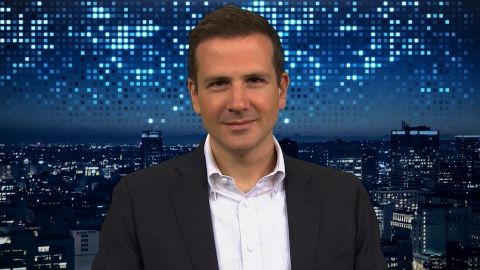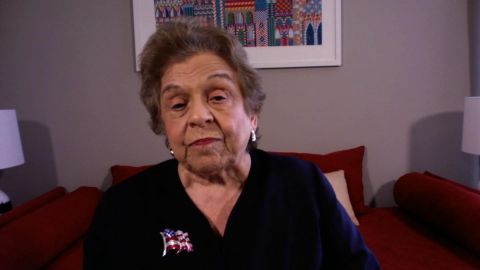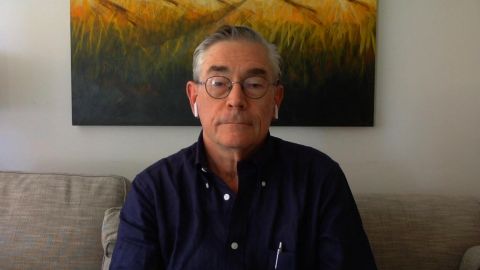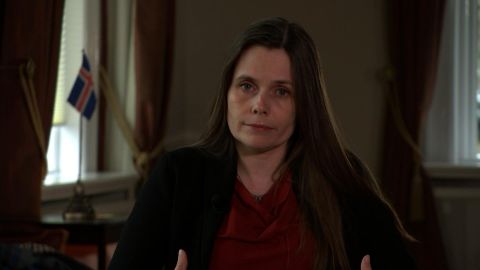Read Transcript EXPAND
CHRISTIANE AMANPOUR: Now, the coronavirus pandemic has brought with it an overwhelming raft of information. And with the science changing so fast, it is fertile ground for conspiracy theories. Our next guest calls it a perfect storm, a global crisis trapped between the medical and political worlds. Dr. F. Perry Wilson is a world-renowned clinical researcher at Yale University and is documenting his life as he works now on a COVID-19 ward. Here’s our Hari Sreenivasan talking to him about his experience and the danger of misinformation.
(BEGIN VIDEOTAPE)
HARI SREENIVASAN: Thanks, Christiane. Dr. Wilson, I want to ask — and in this conversation, perhaps I should start with maybe my own errors, because we are all making them. Just a couple of days ago, I sent out a tweet. And it read: “The coronavirus mutated and appears to be more contagious, new study finds.” I’m a journalist. I think I know how to vet a good source. And then, I don’t know, maybe 24 hours, less, later, I’m also tweeting: “Beware, overblown claims of dangerous coronavirus strains. Lineages vs. strains and mutations,” because that article went through and basically debunked the study that the first article was based on. And if I am falling for this, how can everyone else who’s looking for information about coronavirus get smarter when they see medical research quoted in popular literature?
DR. F. PERRY WILSON, YALE UNIVERSITY: This is a huge challenge right now. The coronavirus pandemic is more or less a perfect storm to have medical information — misinformation be propagated. You have got data coming out faster than we have ever seen before for any disease. It is just a huge rush to publish. You have a very high level of public interest, for obvious reasons, so a lot of these are going to get written about. And then you have, of course, a social media environment which is more complex and has more power to disseminate information, whether good or bad, than ever before. So, we are really seeing what can go wrong and sort of turned up to 11 in this pandemic. And this study can teach us a number of important things. So, just for a little bit of background for your viewers, this was a study that came out of a very well-respected virology genetics group, which looked and found that a certain mutation in the virus — and viruses mutate all the time — but a particular mutation had become very common, particularly in Europe and the United States. That’s data. And there’s no reason that we have to think that that data is incorrect. But, of course, it is the interpretation of the data where people often run into trouble. That paper interpreted that observation as saying, this mutation must be easier to transmit, because it’s spreading, it is spreading faster. That paper was actually a pre-print. It hadn’t undergone peer review yet. And one of the key things that peer review does is, it takes the data and that paper and it sends it to a group of independent researchers with expertise in that area. And their job not just to critique it or pick it apart, but, oftentimes, to add other hypotheses, to say, we’re looking at your data, and there’s another way to interpret this. So, this was before peer review. And the paper said what you are — what you tweeted about, that this mutation seems to be dominant, it’s probably more transmissible. What people realized after the fact is that there’s another explanation here, which is that, when you have a new virus that is seeing a totally — a population that’s completely susceptible to it, that luck of the draw, which viral little mutation happens to get to, let’s say, New York City first is going to disseminate very rapidly, because it’s like a spark landing in a dry brush bed. There’s nothing special about that particular spark. It just happened to be the one that hit the dry brush bed. And so that’s also an interpretation of the data. One of the things we talk about in my online course on interpreting medical studies is that we always have to be cognizant that data can often be interpreted in multiple ways. And we have to be sort of careful about our own biases in terms of looking for those other possibilities.
SREENIVASAN: What went wrong when it comes to hydroxychloroquine? It was part of the national conversation very fast. We added a lot of it to our stockpile. You’re a doctor. You were working on a COVID-positive ward recently, and you kept a diary of it. What was different from the process of reviewing something vs. where we went with it with our — really with our optimism?
WILSON: So, one of the biases that all humans have — and we all engage in this, me too — is motivated reasoning, which is that we have an outcome we want, and we sort of look for data to support that outcome, when the better way to do it is look at the data first, then draw logical conclusions from there. Hydroxychloroquine early on sort of filled this niche for people. It was a drug we had experience with. Most people tolerate it quite well. And some of the studies in the lab using cells in petri dishes and stuff seemed to suggest, yes, it might have an affect on the virus. You then had some very charismatic scientists who were touting their results quite a bit. But some of those studies were quite flawed. So the most famous one was the study in “The International Journal of Antimicrobial Agents.” This was a study directly referenced by President Trump in a tweet from a French group that had treated 20 patients with hydroxychloroquine and 16 without, now, not randomized. They didn’t flip a coin to see who got the treatment, which would be the best possible design, but, nevertheless, they report on these 36 people and said that, in the 20 that got treated with hydroxychloroquine, the viral load decreased more quickly. Very promising. But if you read the paper, what you found was that they excluded six people who got hydroxychloroquine from their analysis. Four of those people died. One of the persons stopped the hydroxychloroquine because of side effects and one was discharged from the hospital. Now, if you exclude people who die from one arm of a study, and you don’t do that from another arm of the study — and no one was excluded from the control arm of this study — well, the arm that doesn’t have any deaths in it because you kicked them out of that arm is going to look better. So, that’s a real flaw that didn’t get picked up on, and yet, nevertheless, this spread like wildfire because we all want it to be true. We want that drug to work or any drug to work. And so, as scientists and as people who are consuming science, we have to be so careful to realize that just because we want something to be true doesn’t mean we can only look at data that supports our beliefs.
SREENIVASAN: I want to get back to the time that you spent when you were chronicling your video diary. What are you seeing when you treat these patients?
WILSON: What I’m seeing is an incredible spectrum of disease. Now, all these patients are in the hospital, so they’re sick enough — these are sick people. They need oxygen. They have fevers. They’re very uncomfortable. There’s a lot of muscle aches and things. But unlike when it’s flu season and things like that, where, unless the patients are kind of very sick to begin with lots of medical issues, you know, everyone kind of does OK, here, we’re seeing even quite healthy people with incredibly severe disease. And it’s that spread between a person who is basically just lying in bed, has a little oxygen in their nose, to in the intensive care unit on dialysis, on a ventilator machine. And you look at the patients and they seem similar. They’re the same age. It’s very disconcerting, particularly for health care providers, because we see young healthy patients getting incredibly sick. And in the back of our heads, as we’re caring for these people, it’s like, OK, I’m in this environment. There’s a decent chance I will catch this at some point. We’re all being careful, but we know that health care workers are at higher risk. Am I going to get the sniffles and maybe need some oxygen, or am I going to end up in the intensive care unit? And even, for me, I’m young. Thankfully, I’m healthy. I don’t have any medical issues. I have seen people like me who have done very badly and even some who have died. Now, that is, I want to say, a small, small percentage. The chances are, if I get sick, I will be fine. The chances are, if most of us get sick, we will be fine. But it is true that we’re seeing, in some people — and we’re not entirely sure what the risk factor is — just kind of catastrophic illness. And that does keep us up at night a bit.
SREENIVASAN: We have a certain impatience. And that means, myself included, in the news cycle, that we will write a headline or that we will look at a study in kind of the initial stages, especially at a time like this, where we’re looking for new bits of information, and nobody necessarily thinks about the fact that it could take several months to review a study, to replicate it. And that’s kind of not the environment that we’re waiting on, because everyone wants to figure out, when can I make a decision for my life, based on — even if I’m thinking good science, based on science?
WILSON: I don’t think it’s reasonable to say, OK, no one report on any studies until they have been thoroughly peer-reviewed and replicated and vetted, because you’re right. It’s just going to take too much time. But what we do have to do is tell our readers and our viewers the number one rule I have for interpreting a medical study, which is that no single study is definitive. You can read something carefully, and you can use rationality to figure this out, but, even if you don’t, you will be safe if you wait for the replication study, the second study to come from a different group. And yet, because of the news cycle, because of how shareable certain headlines can be, we have this vision of science as like a big game-changing, groundbreaking study. And the truth is that there are very, very, very few of those. And, really, science is kind of a slow, plodding process. And even as we report on those studies, we need to remind people that we’re taking step by step by step towards the truth.
SREENIVASAN: One of the things that people are thinking about right now is, how good are the tests, both on the diagnostic level, if I was to get a swab inserted into my nose or any other form of it, and then also on the antibody testing, right? How do I know that these are reliable if they’re not FDA-reviewed? There are several that have an emergency use authorization at this point. I mean, who’s going to help us make sense of that, especially when it comes time to make those decisions on what sorts of lifestyle changes we’re going to make, on whether we’re going to go into office spaces, get into public transit, and so forth?
WILSON: These tests are quite difficult to interpret, actually. You may find that, if you went and got an antibody test, and it comes back positive, and what does that mean for you? Well, the thing that often surprises people is, even if the test only has, let’s say, a 5 percent false positive rate, so that might get reported — it’ll say, OK, you know, out of 100 people who’ve never had coronavirus, five will test positive. You think, oh, that’s pretty good. If you test positive, you will feel like, oh, great, I’m in — I’m in pretty good shape. I probably had it. I’m probably safe. I can go back to work. Well, that’s not exactly right. And the reason it’s not right is because there are more people who haven’t had coronavirus than who have. So just to imagine, if you had 1,000 people who never had coronavirus, and 100 who did, and you did antibody testing, and let’s say all those 100 you captured, positive, great. Five percent of that 1,000 is another 50 people that you’re going to test positive. So, now, if you add that together, you have got 150 people who tested positive, and actually 50 of them never had it. They are the false positives. So, people say, wait, but if there’s supposed to be a 5 percent false positive rate, but now you’re telling me that, based on how many people had been exposed in the population, maybe my chance is only two-thirds that I really had in the past. That’s scary. And I would appreciate a viewer sort of wrinkling their brain, listening to that, thinking, how does that all work? We’re going to have to be really careful not just about the quality of the test, but about the interpretation of the test. And so I’m looking to public officials to be actually quite cautious about what they tell us when it comes to interpreting positive antibody tests. My personal opinion is that we won’t be issuing any COVID passports or antibody-based passports anytime soon because of that very problem.
SREENIVASAN: Regarding testing, right now, there’s a sort of storyline that reveals that folks in the White House have been testing positive for coronavirus. But what’s more intriguing to me is the level of testing and access to testing that they have, meaning people who are closer and closer to the president are tested almost to a daily basis, and people who are further away are getting tests perhaps every week. How frequently will we be testing to make sure that our whatever community is, whether it’s a work community, a church community, a school community, is safe to be interacting?
WILSON: I think, in terms of what’s happening around the president, which are what are known as the PCR tests — so that shows active, live virus. This is not feasible on a national scale. There’s — there’s no sign that we’re anywhere close to having that number of tests available or the bandwidth to process them. So, would it be nice? Maybe, but it’s not going to happen. Now, antibody testing is a different story, because once, presumably, you confirm you’re antibody-positive, and assuming it’s a true positive, then you are positive forevermore. So, you don’t need to do that repeat testing. We don’t have the capacity to antibody-test everyone either. But we can be very precise about doing what are called seroprevalence surveys, which means you go into a community where there’s transmission of coronavirus, and epidemiologists and scientists randomly sample people in a very careful way, certain neighborhoods and certain age groups. You don’t necessarily test every single person, but you test representative samples from a bunch of different groups to kind of create a map of how the disease is spreading throughout a community. I think that’s our best way forward in terms of understanding the sort of undercurrent of what’s happening with this disease, because what we’re seeing are people in the hospital. We know there’s transmission outside of the hospital. We know there are people with mild disease, but we really have no idea if that’s 50 percent of all the cases or, like, 95 percent of all the cases at this point.
SREENIVASAN: Where do you rank the White House in the quality of information in the medical context that’s coming out of it? Because it seems that, by not wearing masks while you’re having meetings, even though the CDC and public health experts say that you should, social distance, you sending mixed messages here?
WILSON: I’m quite concerned about this. A lot of focus on the administration’s response has revolved around testing. And it is clear that a robust testing protocol is needed to reopen society. But there’s something else that’s going on here. Americans don’t like being told what to do. We’re an independent people. And so rules and regulations, and wear a mask, and stand six feet apart, there is a tendency, I think, for people to say, you know what, no. You can’t tell me what to do. Individual liberty is paramount. But there have been times in history where Americans have embraced a shared sacrifice. And an important part of reopening safely is lifestyle change on all of our parts. Doors are going to open. Stores are going to reopen. We can’t keep things closed forever. All we have to do to really cut down on transmission is to behave in really simple, appropriate ways, to wear that mask, to wash your hands, to do the social distancing, to keep large gatherings from agglomerating too many people together. And you don’t have to tell people or order people to do this. I don’t think they respond as well to that. What you need to do is demonstrate it. You need to say, it is patriotic to wear a mask. It is patriotic to give space to your neighbors. We need to work together, as Americans, right now to save our country from this disease. And I wish the government would do a bit of a better job of modeling that behavior, not because they are being told to by the CDC, who are scientists and have good data to support it, but, in this case, because it’s the patriotic thing to do, and it’s the right thing to do, because, when bad things are happening, Americans come together to support each other. They don’t become fiercely independent survivalists.
SREENIVASAN: Dr. Perry Wilson, thanks so much for joining us.
WILSON: Thanks. My pleasure.
About This Episode EXPAND
Christiane Amanpour speaks with U.S. Rep. Donna Shalala about today’s U.S. Senate hearing and science reporter Donald G. McNeil Jr. about the country’s roadmap out of the pandemic. She also speaks with Icelandic Prime Minister Katrín Jakobsdóttir about keeping the country’s tourism-based economy alive. Hari Sreenivasan talks to Dr. F. Perry Wilson about the tension between politics and medicine.
LEARN MORE



